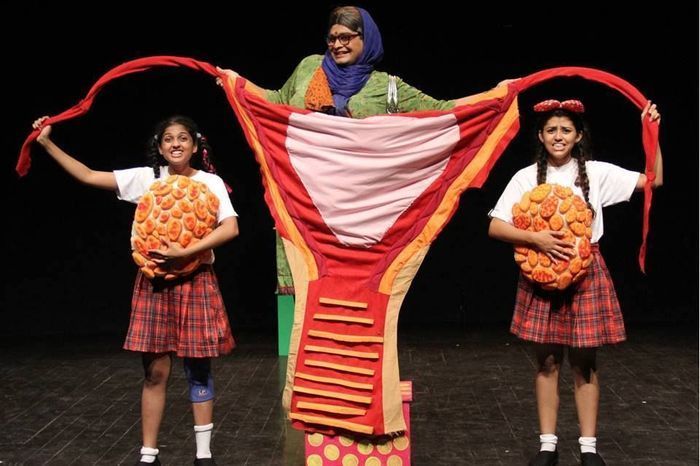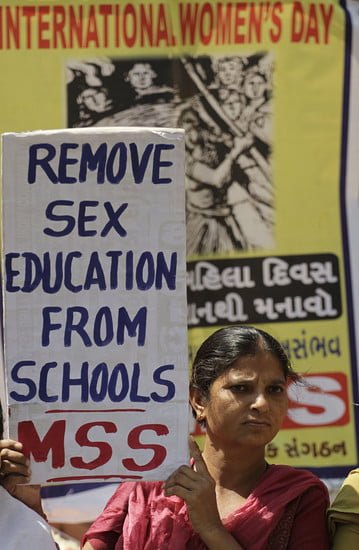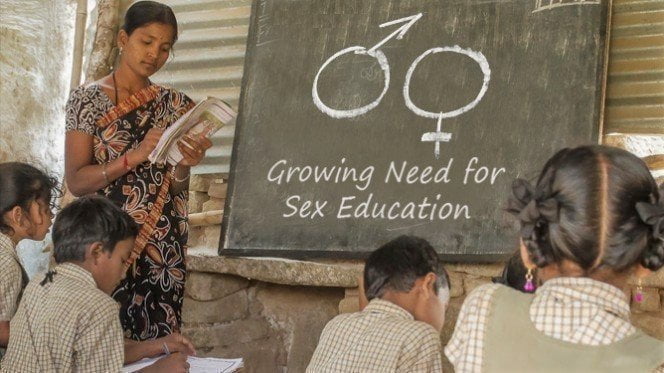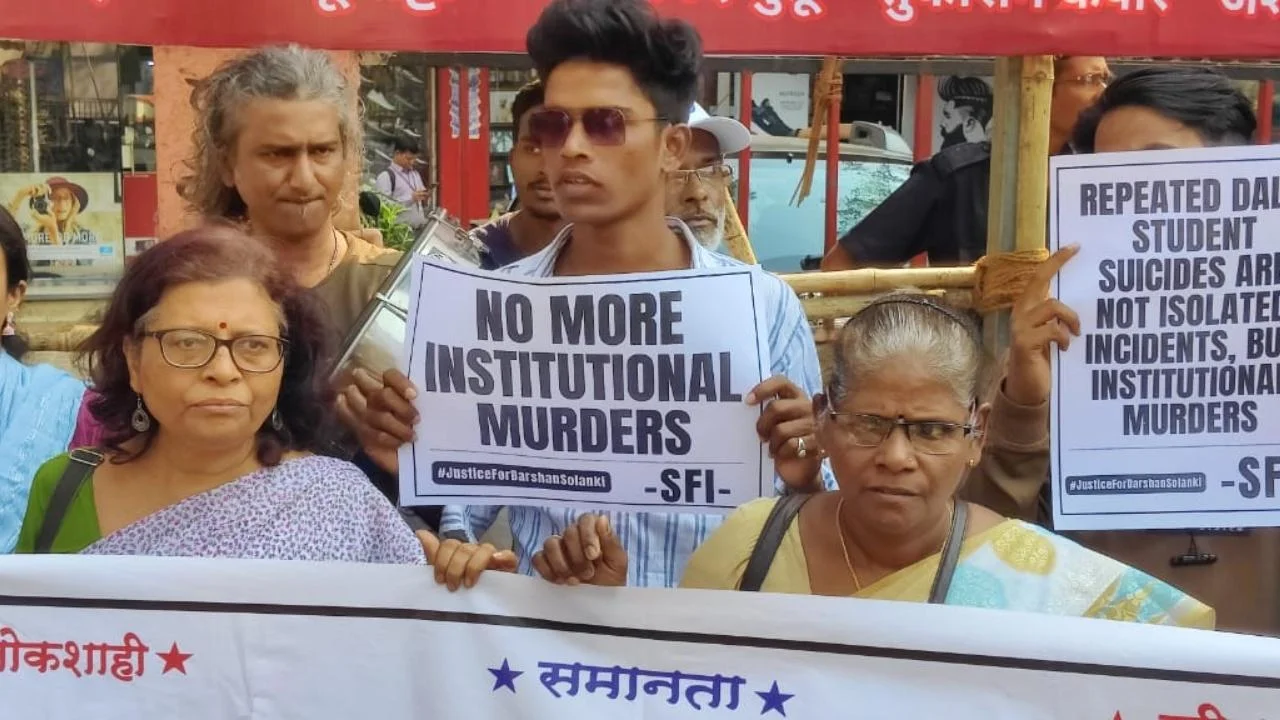Sex education can be defined as programs offering information on sexuality and contraception. This also encompasses the gender identity, consent and awareness about sexual abuse. It aims to develop awareness around sexual health. Prior the feminist phrase came into being, ‘the personal is political’, sex education was thoroughly considered to be ‘personal’ matter. It is during 1960s in the West, when sex education’s political aspects have been provided consideration. But the dominant issue in the debate has been, are the social mores and particularly the sexual mores either to be inculcated by schools or families?

‘Sex Education’ is again designed in a way to enlighten child about the birth processes. As Angala M. Salas has argued, in realty most sex education occurs outside the classroom. It is also with the acknowledgement of the growing ‘child sexual abuse’, sex education is thereby given importance in bits and pieces. Again the milieu under which the students are socialised is heterosexist in nature. It is often considered that these educative values would necessarily lead to identity formation and affect the behavioural patterns. It has been viewed that excessive ‘openness’ towards simply knowing about same-sex relationships, especially when these relationships are presented in a positive way, can make child more likely to become ‘homosexual’. School is not considered to be the ideal place where much concern should be provided to the idea of homosexuality.
Reports
Children are curious about sex and sexuality as there is always a sense of ‘hush-hush’ around such topics. Freud suggests that, it creates within them a fundamental conflict which he calls the ‘ideals of education’. Children want to know about sexuality, but the grown-ups tell them they need to know about something else. In India, from the late 1980’s growing awareness about the AIDS epidemic made it increasingly legitimate to talk of sex outside the realm of law, demography and medicine and not only as violence against women or in terms of population control. Autonomous women’s groups from the late 1970’s had started with the discussion on sexuality, including lesbian sexuality. But however, AIDS awareness helped to produce a critical understanding in the public sphere.
Autonomous women’s groups from the late 1970’s had started with the discussion on sexuality, including lesbian sexuality. But however, AIDS awareness helped to produce a critical understanding in the public sphere.
In India, while talking about sex education, much emphasis is given on teenage pregnancy and HIV/AIDS infection. It has often been observed that there is lack of awareness not only with regard to ‘homosexuality’ but also ‘menstruation’. In spite of having discussions around teenage pregnancy, there is also a lack of awareness around safe sex.
Despite the current growing awareness around child sexual abuse, there are still very little attempts taken by schools to incorporate the understanding of difference between the non-sexual and sexual touch. A study conducted by the Indian Ministry of Women and Childr Development and carried out by UNICEF and Prayas, a non-governmental organization provides us insight about these issues. They interviewed 12,247 children and 2324 young adults in 13 Indian states. The study revealed that a shocking 53% of children between the ages of 5 and 12 have been sexually abused. Most often, this abuse was perpetrated by parents, legal guardians or close members of the family. Further, the study disturbingly notes that more than half of all these cases of sexual abuse and rape go unreported.

In 2005, Central Board Secondary Education (CBSE) issued a circular, introducing a program called, ‘The Adolescence Reproductive and Sexual Health Education’ (ASRH project). The central government released it in 2006. Though it was incorporated by few states, however, they adopted the project with variations according to what they considered to be important.
A report on sexuality education in India by the ‘Youth Coalition for Sexual and Reproductive Rights’, an international organization noted that, ‘Most schools, private and public affiliated state boards of secondary education don’t have any form of sexuality education in their curriculum’. The government of India initiated ‘Adolescent Education Program’ (AEP) in 2007 in collaboration with National AIDS Control Organization (NACO) and United Nations Children’s Fund (UNICEF).
According to MHRD, this was an important initiative that aimed to ‘empower young people with accurate, age appropriate and culturally relevant information, promote healthy attitudes and develop skills to enable them to respond to real life situations in positive ways’. However, although this programme covers issues such as body image, violence and abuse, gender and sexuality and STIs, substance abuse, especially drugs and other unhealthy attitudes, the notion of ‘consent’ and ‘attraction’ was neither introduced nor incorporated in this program. The program was not implemented and was banned by 12 Indian state governments as the program’s content was considered to be ‘inappropriate’. There has been constant claim that the incorporation of sex education will increase ‘risky-behaviour’ amongst adolescents and young students.
The government of India initiated ‘Adolescent Education Program’ (AEP) in 2007 in collaboration with National AIDS Control Organization (NACO) and United Nations Children’s Fund (UNICEF). However, although this programme covers issues such as body image, violence and abuse, gender and sexuality and STIs, substance abuse, especially drugs and other unhealthy attitudes, the notion of ‘consent’ and ‘attraction’ was neither introduced nor incorporated in this program.
Positive Developments
In 1994, the United Nations International Conference on Population and Development (ICPD) and its Five Year Review member states of the UN including India, affirmed the Sexual and Reproductive Rights (SRRs) of adolescents and young people. This was an attempt so that adolescents and young people can freely make informed decisions on all matters relating to their sexuality and reproduction. It thereby acknowledged that they require comprehensive sexuality education. Therefore, as a part of commitments under the ICPD agenda, governments are obliged to provide for free and compulsory comprehensive sexuality education for adolescents and young people.
In India, private schools have the liberty to choose whether to include sexuality education in their curricula or not. However, no such attempts have been made from the public schools. There was no response from the central government against the decisions of the state governments of banning AEP. In 2016, Telengana became the first Indian state to make ‘gender’ education compulsory at the graduate level and has also introduced a bilingual textbook, ‘Towards a World of Equals’.
MHRD’s 2016-2017 report suggests certain new initiatives aiming to make India a more knowledgeable nation. UGC has been notified that it is mandatory in higher educational institutions to have, anti-ragging cell, anti-discrimination cell, gender sensitisation cell.
Also read: Recommendations On Draft New Education Policy 2019 From A Gender And Sexuality Lens
It is also important to talk about various schemes adopted mentioned in the reports in terms of schools under ‘Kendriya Vidyalay Sanghatan’. Seema Darshan is an initiative adopted by the ministry of human resource development, to provide an opportunity for the children to experience the broader environment and to foster patriotism and nationalism amongst the students. The report suggests that the most striking outcome of the programme was the change in the thinking of the children which influenced them positively as they expressed their ‘wish’ to take up a ‘career with the defense forces and serve the motherland’. An ERP platform for 1100+ schools to enhance academic delivery and improving overall quality of education. The schemes also involved the objective of reducing usage of paper in the school and also thereby reducing the cutting of trees. However, there is no mention of incorporation of the compulsory sex education as any of the scheme adopted under these new initiatives.
The term ‘sex’ and ‘sexuality’ carries a lot of taboo within the premise of the school especially in presence of authority. In most schools, there is a complete lack of proper dialogue around sexuality education. Even if there are certain attempts of initiating conversations, it did not cross the line beyond menstrual hygiene. Even if there is conversation around sexuality between teachers and students, it takes place very informally.

In the context of elementary education, following the National Curriculum Framework (NGF), 2005 guidelines, states have consciously taken a decision to establish gender as critical marker of transformation through increasing visual representation of girls and facilitating role reversal. It has been claimed in the report that most of the states have incorporated the gender sensitization in their regular school management committee (SMC) training modules to deal with issues such as enrolment, retention and completion of education of girls; creating suitable atmosphere for girls in schools; rapport with female teachers for discussing gender awareness etc., training of teachers on gender related issues are organised in the states specifically for orientation on gender issues faced by adolescent girls in particular.
The curriculum of sex and sexuality education is essential for the students to be sensitized from a very young age. This is also important to be taken into account that the content must be contextually relevant and age appropriate. The unreliable sources of information on these topics may act extremely harmful for the growth of the individuals as well as for the boasting of self-esteem and confidence.
Also read: It’s 2020! Why Are We Still So Afraid To Talk About Sex And Sexuality?
However, even in the component to be included as a part of sex education, the discourse of ‘attraction’ has often been rendered invisible. This also emphasises on the importance of introduction of an inclusive pedagogy which shall challenge the compulsory heterosexual understanding. Such an initiative shall also help to start a dialogue around policing in schools in the name of gender and sexuality both by peers and authority. This shall help to create a sense of empathy and sensitivity amongst the school goers so that they can look beyond the envelope of social stigma by conquering hope and escaping fear.
References
- Policies and programmes on adolescent education’, Shodhganga
- ‘Sexuality in School: The limits of Education’ by Jen Gilbert
- ‘Adolescent Sex Education in India: Current perspective- NCBI- NIH (2015)’
- Live Mint
- Press Information Bureau Government of India Ministry of Health and Family Welfare
- Why is sex education important in India? by Arthreye Viji
Featured Image Source: Change.org
About the author(s)
Joyoti Chowdhury is a Sociology Student with the hope of emancipation to create an egalitarian reality.





Not a problem till Christians n Islam arrived
Christianity will crush feminism everyday.